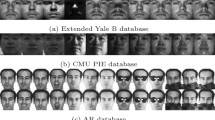Abstract
Face recognition (FR) has been one of the most fundamental problems in computer vision. Two issues are always concerned in a FR task: one is the dimensionality reduction (DR) of the features, and the other is the sparse representation for the samples. DR is an important step because it can not only reduce the storage space of face images, but also enhance the discrimination of the features. Meanwhile, sparse representation based classification (SRC) has been proved a powerful method to solve the problem of dimensionality. It simply considers the training samples as the dictionary to represent the testing samples. However, most of the SRC algorithms do not consider the structure of the dictionary. To consider these two aspects, in this paper, we proposed a FR method by combining a new DR model with the structured sparse representation (SSR). The key idea is projecting the images on a learned projection matrix, and performing the face classification by the SSR considering the structure information of the dictionary. The validity of the proposed method is verified by the evaluations on three databases.



Similar content being viewed by others
Explore related subjects
Discover the latest articles, news and stories from top researchers in related subjects.References
Azeem A, Sharif M, Raza M et al (2014) A survey: face recognition techniques under partial occlusion. Int Arab J Inf Technol 11:1–10
Belhumeur P, Hespanha J, Kriegman D (1997) Eigenfaces vs. fisherfaces: recognition using class specific linear projection. IEEE Trans Pattern Anal Mach Intell 19:711–720
Chen D, Ren S, Wei Y et al (2014) Joint cascade face detection and alignment. ECCV 8694:109–122
Chen T, Su F (2012) Facial expression recognition via gabor wavelet and structured sparse representation. IC-NIDC, pp 420–424
Eldar YC, Mishali M (2009) Robust recovery of signals from a structured union of subspaces. IEEE Trans Inf Theory 55:5302–5316
Elhamifar E, Vidal R (2011) Robust classification using structured sparse representation. CVPR, pp. 1873–1879
Feng Z, Yang M, Zhang L et al (2013) Joint discriminative dimensionality reduction and dictionary learning for face recognition. Pattern Recognit 46:2134–2143
Gao S, Jia K, Zhuang L et al (2015) Neither global nor local: regularized patch-based representation for single sample per person face recognition. Int J Comput Vis 111:365–383
He X, Yan S, Hu Y et al (2005) Face recognition using laplacianfaces. IEEE Trans Pattern Anal Mach Intell 27:328–340
Hu ZP (2014) Discriminative decomposition structure-sparse representation for face recognition with occlusion. J Signal Process 30:214–220
Kim S, Koh K, Lustig M et al (2007) An interior-point method for large-scale l1-regularized least squares problems with applications in signal and statistics. IEEE J Sel Top Signal Process 1:606–617
Kuang-Chih L, Ho J, Kriegman D (2005) Acquiring linear subspaces for face recognition under variable lighting. IEEE Trans Pattern Anal Mach Intell 27:684–698
Martinez AM (1998) The AR face database. CVC technical report
Olshausen BA, Field DJ (1997) Sparse coding with an overcomplete basis set: a strategy employed by V1? Vis Res 37:3311–3325
Phillips PJ, Flynn PJ, Scruggs T et al (2005) Overview of the face recognition grand challenge. CVPR, pp 947–954
Roweis ST, Saul LK (2000) Nonlinear dimensionality reduction by locally linear embedding. Science 290:2323–2326
Shah JH, Sharif M, Raza M et al (2013) A survey: linear and nonlinear pca based face recognition techniques. Int Arab J Inf Technol 10:536–545
Tenenbaum JB, De Silva V, Langford JC (2000) A global geometric framework for nonlinear dimensionality reduction. Science 290:2319–2323
Turk M, Pentland A (1991) Eigenfaces for recognition. J Cognit Neurosci 3:71–86
Wright J, Yang AY, Ganesh A et al (2009) Robust face recognition via sparse representation. IEEE Trans Pattern Anal Mach Intell 31:210–227
Yang J, Zhang D, Yang JY et al (2007) Globally maximizing, locally minimizing: unsupervised discriminant projection with applications to face and palm biometrics. IEEE Trans Pattern Anal Mach Intell 29:650–664
Yang M, Zhang D, Feng X et al (2011) Fisher discrimination dictionary learning for sparse representation. ICCV, pp 543–550
Yang M, Zhang L, Yang J et al (2010) Metaface learning for sparse representation based face recognition. ICIP, pp 1601–1604
Zhang L, Zhou W, Li F (2015) Kernel sparse representation-based classifier ensemble for face recognition. Multimed Tools Appl 74:123–137
Zhang D, Meng Y, Zhao F et al (2010) On the dimensionality reduction for sparse representation based face recognition. ICPR, pp 1237–1240
Zhao W, Chellappa R, Phillips PJ et al (2003) Face recognition: a literature survey. ACM Comput Surv (CSUR) 35:399–458
Zhuang L, Chan TH, Yang A et al (2015) Sparse illumination learning and transfer for single-sample face recognition with image corruption and misalignment. Int J Comput Vis 114:272–287
Zhuang L, Yang A, Shankar SS et al (2013) Single-sample face recognition with image corruption and misalignment via sparse illumination transfer. CVPR, pp 3546–3553
Acknowledgments
This work was partly supported by Natural Science Foundation of China (No. 61303128), Natural Science Foundation of Hebei Province (Nos. F2013203220, F2014203132), Key Foundation of Hebei Educational Committee (ZD2015095) and Youth Foundation of Hebei Educational Committee (Q2012047).
Author information
Authors and Affiliations
Corresponding author
Rights and permissions
About this article
Cite this article
Gu, G., Hou, Z., Chen, C. et al. A dimensionality reduction method based on structured sparse representation for face recognition. Artif Intell Rev 46, 431–443 (2016). https://doi.org/10.1007/s10462-016-9470-1
Published:
Issue Date:
DOI: https://doi.org/10.1007/s10462-016-9470-1




